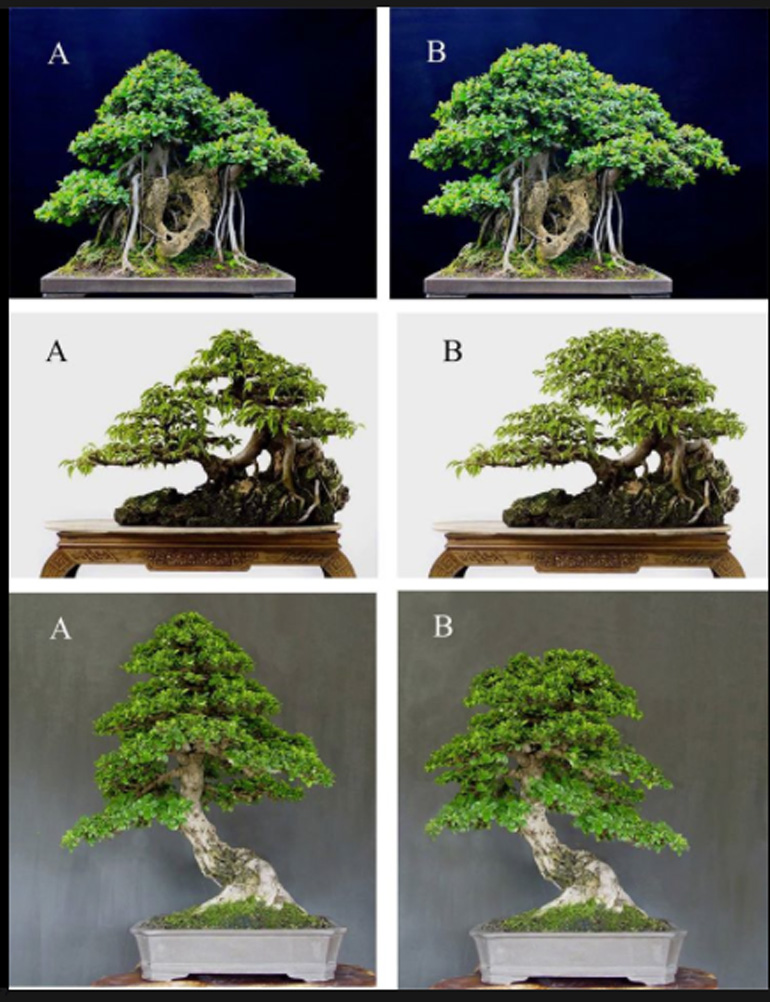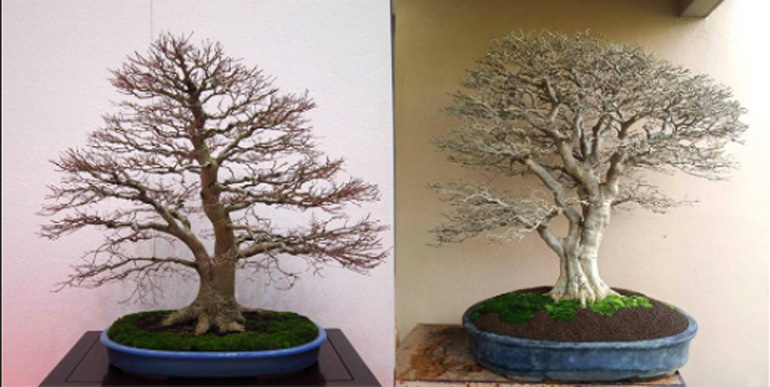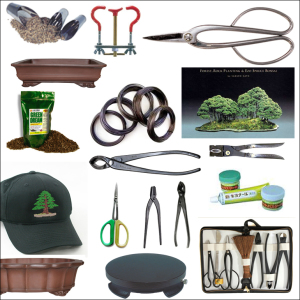
I got a little feedback in the comments from this morning’s post. One reminded me that not everyone uses facebook. Making the links provided worthless to these non-facebook folks. So, I’ll fill in a bit…
The three trees on the left (above) are tropicals that are shaped like conifers. To Robert Steven and to many others, this a mistake. A common mistake to be sure, but still a mistake.
The three trees on the right have more rounded and therefore natural looking tropical tree crowns. This more or less rounded look is also generally found on deciduous (see below) and broadleaf evergreens.
Many very serious and highly accomplished bonsai artists (even bonsai masters) take these basic principles very seriously when it comes to designing bonsai. Other people don’t seem to care all that much.
 Two deciduous bonsai. The one on the left has a conifer shaped crown. The one on the right has a broad crown, more like what you find with most deciduous trees.
Two deciduous bonsai. The one on the left has a conifer shaped crown. The one on the right has a broad crown, more like what you find with most deciduous trees.
And just in case you missed it…
We are offering 20% to 30% off Everything at Stone Lantern
Right now, but not for long

I’ve been around bonsai long enough to remember when those of us in the tropics were busy finding the apex on every bonsai we created!
Thanks to Adan Montalvo in Puerto Rico and Joe Samuels in Miami we were introduced to canopies! Then styling began to take on a new look. (It still took a while to learn about the space for birds to fly through!)
Thanks to wayne for sharing. See the complete post here with photo examples :
https://www.facebook.com/groups/721360507936301/permalink/882361521836198/
And here for those who don’t have FB :
“Deciduous vs Conifers”
If there is any “fault list” in bonsai art, one I can think of is to design tropical/ broad leaves/ deciduous bonsai like conifers; and it’s sad that this “mistake” is still being taught and practiced all over the world.
Not for right or wrong reason, but they are all about plant physiology and morphology that make the distinctive different between tropical/ broad leaves/ deciduous and conifers on their structures and characters.
The main difference which becomes very important to bonsai design is the “apical dominant” of conifers and only found very few exceptions on deciduous tree, unless they are still young. The apical dominant feature is not only on the trunk line but also on the branch structure. Consequently, conifers tend to grow in monopodial form with apical crown shape unless being influenced by external factors from nature, and the ramification structure is different from deciduous tree that tend to grow wider.
As most of us learn bonsai from Japanese oriented sources, and they are mostly for conifers (not many tropical bonsai in Japan), so most of the technique do not fit to design tropical/ deciduous/ broad leaves bonsai, specifically on the ramification structure and crown shape where we are always taught to make a triangular shape with single line to form the apex. Only young deciduous trees grow in apical shape with very few exceptions, but old deciduous tree will always grow wider in sympodial structure with “non” apical dominant ramification structure as conifers do.
So we are not suppose to design our deciduous bonsai in such way, but we can design our conifers like deciduous. Why ? Because when the apical meristerm of conifers are disturbed (e.g. by ice balls, strong wind etc.), then the structure will change and transform the tree shape. This is what I refer to the morphological aspect.
Another common “mistake” is the technique to make a bonsai look older by bending the branch downward. It is true that the branches of old tree will bend down, but once again, many people are using the technique for deciduous by bending down the branch from the very beginning point that form a sharp 45 degree angle on the lower part. This only happens in pines; the branches of deciduous tree will always grow upward from the beginning, when they get older then will bend downward but keep the angle on the upper part.
These are the “mistakes” which always make deciduous bonsai look like a pine or conifers.
Thank you to Wayne and Robert for clearing that up. I recently asked the question on the IBC and got some interesting answers.
Marco, can you give me the link to the post at IBC because I can not find the discussion. Just curious to see how others say…